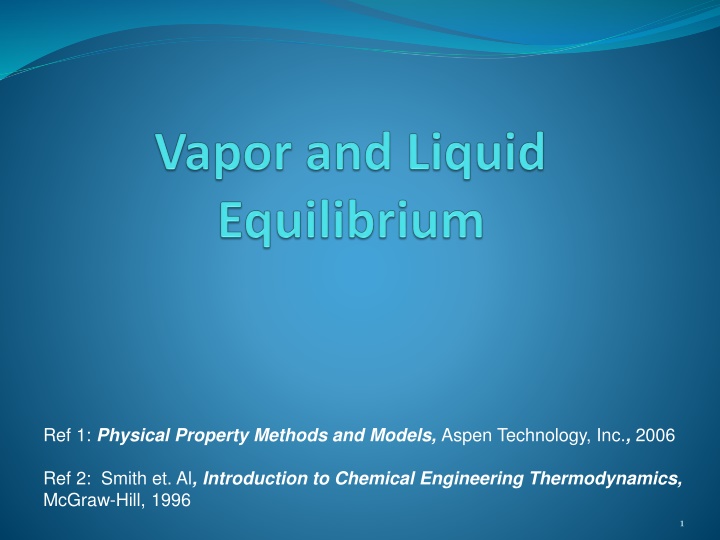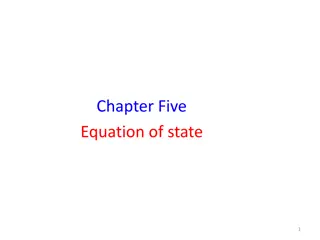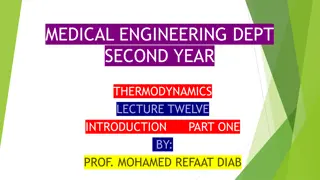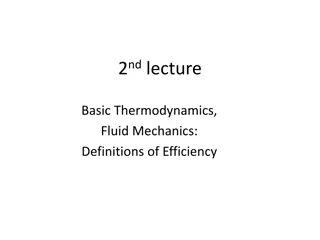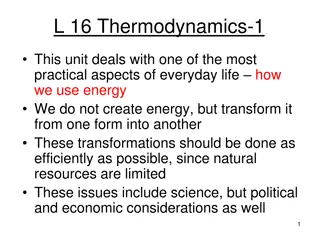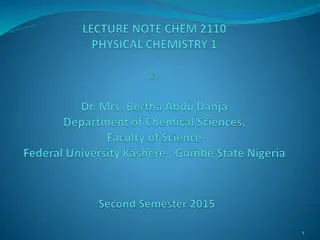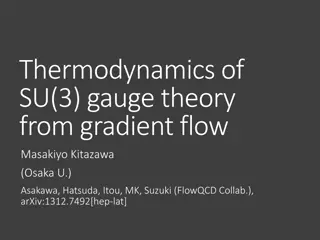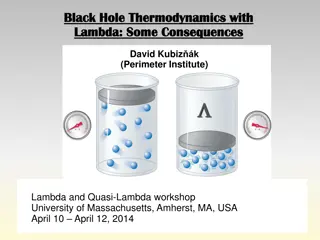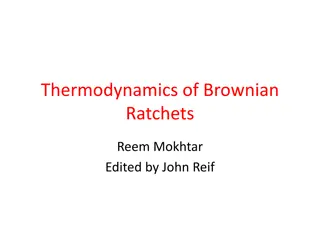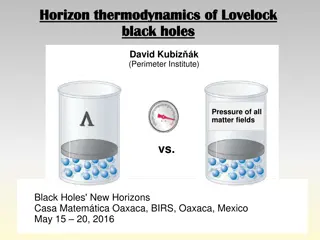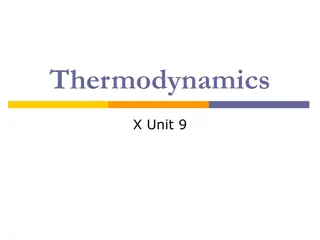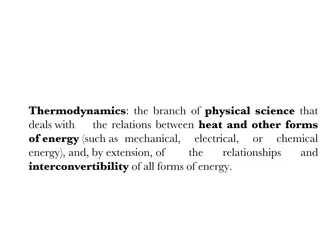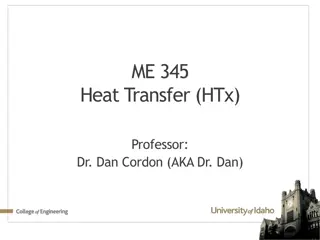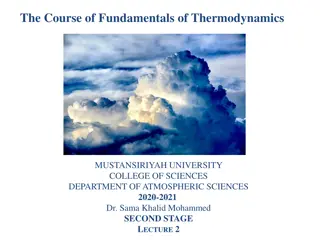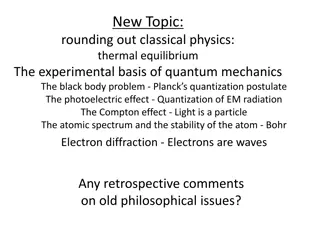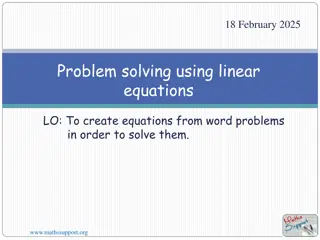Equations of State in Thermodynamics
various Equations of State (EOS) methods such as Redlich-Kwong, Peng-Robinson, and their applications in VLE calculations. Advantages, disadvantages, and modeling capabilities for different chemical systems.
Download Presentation

Please find below an Image/Link to download the presentation.
The content on the website is provided AS IS for your information and personal use only. It may not be sold, licensed, or shared on other websites without obtaining consent from the author.If you encounter any issues during the download, it is possible that the publisher has removed the file from their server.
You are allowed to download the files provided on this website for personal or commercial use, subject to the condition that they are used lawfully. All files are the property of their respective owners.
The content on the website is provided AS IS for your information and personal use only. It may not be sold, licensed, or shared on other websites without obtaining consent from the author.
E N D
Presentation Transcript
Ref 1: Physical Property Methods and Models, Aspen Technology, Inc., 2006 Ref 2:Smith et. Al, Introduction to Chemical Engineering Thermodynamics, McGraw-Hill, 1996 1
VLE (EOS Method) f = v l f At Equilibrium: i i = = v v i l l , f y P f x P Where i i t i i i t l y = = vl i i i k Therefore v i x i 2
VLE (EOS Method) ( ) nZ dP P = ln 1 i n P 0 i , , T P n j = compressib ility factor Z Cubic Equations of State in the Aspen Physical Property System Redlich-Kwong(-Soave) based Redlich-Kwong (RK) Standard Redlich-Kwong-Soave(RK-SOAVE ) Redlich-Kwong-Soave (RKS-BM) Redlich-Kwong-ASPEN(RK-ASPEN) Schwartzentruber-Renon Redlich-Kwong-Soave-MHV2 Predictive SRK (PSRK) Redlich-Kwong-Soave-WS Peng-Robinson based Standard Peng-Robinson(PENG-ROB) Peng-Robinson(PR-BM) Peng-Robinson-MHV2 Peng-Robinson-WS 3
VLE (EOS Method) Standard RK-SOAVE V RT PV aV = = Z + ( ) V b RTV V b Where i i = = 5 . 0 ( ) 1 ( , ) a x x a a k b x b i j i j ij i i j 2 2 R T RT 42747 . 0 = = , 08664 . 0 ci ci a b i i i P P ci ci = + = . 1 + 5 . 0 ri 2 2 i ( ) 1 [ 1 ( i )] , . 0 48 57 . 0 176 T m T m i i i 4
VLE (EOS Method) Standard PENG-ROB V aV = Z + + [ ( ) ( )] V b RT V V b b V b Where i i = = 5 . 0 ( ) 1 ( , ) a x x a a k b x b i j i j ij i i j 2 2 R T RT 45724 . 0 = = , 07780 . 0 ci ci a b i i i P P ci ci = + = 54226 . 1 + 26992 . 0 5 . 0 ri 2 2 i ( ) 1 [ 1 ( i )] , 37464 . 0 T m T m i i i 5
VLE (EOS Method) Advantages and Disadvantages Equations of state can be used over wide ranges of temperature and pressure, including subcritical and supercritical regions. Thermodynamic properties for both the vapor and liquid phases can be computed with a minimum amount of component data. For the best representation of non-ideal systems, you must obtain binary interaction parameters from regression of experimental VLE data. Binary parameters for many component pairs are available in the Aspen databanks. 6
VLE (EOS Method) Advantages and Disadvantages Equations of state are suitable for modeling hydrocarbon systems with light gases such as CO2 , N2 and H2 S . The assumptions in the simpler equations of state (SRK, PR, Lee-Kesler , ) are not capable of representing highly non-ideal chemical systems, such as alcohol-water systems. Use the activity-coefficient options sets for these systems at low pressures. At high pressures, use the predictive equations of state. 7
VLE (Activity Coefficient Method) f = v l f At Equilibrium: Where Therefore i i = = *, v v i l l , f y P f x f i i t i i i i *, l y f = = vl i i i i k v i x P i t F0r ideal gas and liquid , 1 = * y P = = = v i vl i 1 ' i i k Raoult s Law i x P i t 8
VLE (Activity Coefficient Method) Liquid Phase Reference Fugacity For solvents: The reference state for a solvent is defined as pure component in the liquid state, at the temperature and pressure of the system. = *, *, i *, *, *, i l v l l l ( , ) , ( 1 ) 1 f T P P as x i i i i i i*,v= Fugacity coefficient of pure component i at the system temperature and vapor pressures, as calculated from the vapor phase equation of state 1 P i*,l= Poynting factor = *, *, l l exp V dP i i RT *, l P i 9
VLE (Activity Coefficient Method) Liquid Phase Reference Fugacity For dissolved gases: Light gases (such as O2 and N2 ) are usually supercritical at the temperature and pressure of the solution. In that case pure component vapor pressure is meaningless and therefore it cannot serve as the reference fugacity. = * i * i l 1 0 f x H and as x i i i i Using an Empirical Correlation: The reference state fugacity is calculated using an empirical correlation. Examples are the Chao-Seader or the Grayson-Streed model. 10
VLE (Activity Coefficient Method) Multi-component Mixtures Multicomponent vapor-liquid equilibria are calculated from binary parameters. These parameters are usually fitted to binary phase equilibrium data (and not multicomponent data) and represent therefore binary information. The prediction of multicomponent phase behavior from binary information is generally good. Multi-component liquid-liquid equilibria cannot be reliably predicted from binary interaction parameters fitted to binary data only. In general, regression of binary parameters from multi-component data will be necessary. 11
VLE (Activity Coefficient Method) NRTL (Non-Random Two-Liquid) The NRTL model calculates liquid activity coefficients for the following property methods: NRTL, NRTL-2, NRTL-HOC, NRTL-NTH, and NRTL-RK. It is recommended for highly nonideal chemical systems, and can be used for VLE, LLE and VLLE applications. j m j x G x G ji ji x G m mj mj j j x ij G = + ln k k k i ij x G x G k ki k kj k kj 12
VLE (Activity Coefficient Method) NRTL (Non-Random Two-Liquid) j m j x G x G ji ji x G m mj mj j j x ij G = + ln k k k i ij x G x G k ki k kj k kj Where = = exp( ) , 1 G G ij ij ij ii = + + + = ln , 0 a b T e T f T ij ij ij ij ij ii = + ( 273 15 . ) c d T ij ij ij The binary parameters aij, bij, cij, dij, eijand fijcan be determined from VLE and/or LLE data regression. The Aspen Physical Property System has a large number of built-in binary parameters for the NRTL model. 13
VLE (Activity Coefficient Method) Advantages and Disadvantages The activity coefficient method is the best way to represent highly non-ideal liquid mixtures at low pressures. You must estimate or obtain binary parameters from experimental data, such as phase equilibrium data. Binary parameters are valid only over the temperature and pressure ranges of the data. The activity coefficient approach should be used only at low pressures (below 10 atm). The Wilson model cannot describe liquid-liquid separation at all; UNIQUAC, UNIFAC and NRTL are suitable. 14
Principle Steps in Selecting the Appropriate Method for VLE 1. Choosing the most suitable method based on the nature of chemical species. 2. Comparing the obtained predictions with data from the literature. 3. Estimate or obtain binary parameters from experimental data if necessary. 4. Generation of lab data if necessary to check the property model. 15
VLE Bubble Point and Dew Point PTxy diagram for VLE for a two component mixture is as shown. If one starts with a liquid at F (subcooled liquid) and reduces the pressure at constant temperature and composition along vertical line FG, the first bubble of vapor appears at point L, which lies on the upper surface. Thus, L is a bubblepoint(saturated liquid), and the upper surface is the bubblepoint surface. 16
VLE Bubble Point and Dew Point The state of the vapor bubble in equilibrium with the liquid at L must be represented by a point on the under surface at the temperature and pressure of L. This point is indicated by V. Line VL is an example of a tie line, which connects points representing phases in equilibrium (saturated liquid to saturated vapor). 17
VLE Bubble Point and Dew Point As the pressure is further reduced along line FG, more and more liquid vaporizes until at W the process is complete. Since W is the point at which the last drops of liquid (dew) disappear, it is a dewpoint (saturated vapor), and the lower surface is the dewpoint surface. Continued reduction of pressure merely leads into the superheated vapor region. 18
VLE Bubble Point and Dew Point Pxy diagram Txy diagram 19
VLE Ideal Model At equilibrium: V L _ _ f f = j j y P x f xP xP yP y P = V L j j j j j = s 1 1 1 = s 2 2 2 P xP xP xP ( 1 x P ) = + = + s s s s 1 1 2 2 1 1 1 2 P ( P P x ) = + s s s 2 1 2 1 At fixed temperature 20
VLE Ideal Model Example Phase diagrams for benzene-toluene mixture at 90 oC 21
VLE Homogeneous Azeotropes yP y P x P x = = For non-ideal mixtures, the activity coefficients are different from unity: S 1 1 1 1 P S 2 1 2 2 2 P x P ( x ) P = + s s 1 1 1 1 2 2 1 If the mixture may have a minimum-boiling azeotrope i Example Phase diagrams for Isopropyl ether-Isopropyl alcohol 22
VLE Homogeneous Azeotropes yP yP x P x = = For non-ideal mixtures, the activity coefficients are different from unity: S 1 1 1 1 P S 2 2 2 2 P x P ( 1 x ) P = + s s 1 1 1 1 2 2 1 If the mixture may have a maximum-boiling azeotrope i Example Phase diagrams for Acetone-Chloroform 23
VLE Heterogeneous Azeotropes For a minimum-boiling azeotrope with large deviation from Raoult s law ( ), phase splitting may occur and a minimum-boiling heterogeneous azeotrope forms, having a vapor phase in equilibrium with two liquid phases. i usually , 1 7 Homogeneous Azeotrope Heterogeneous Azeotrope 24
VLE Dew and Bubble Point Calculations sat v i x P y P = = i i i i ) I ( or ( II ) y x At Equilibrium: i i v i sat P P i i Where: = v i ( T , , , , x , ) T P y y y 1 2 1 N = ( , , , ) x x 1 2 1 i N B = sat i exp Antoine Eq. P A i i + T C i Since and , we also have: 1 = i i i = 1 iy ix sat x P 1 y = = i i i (III) and (IV) P P v i v i i i P sat i i 25
VLE BUBL P: Calculate {yi} and P, given {xi} and T 26
VLE DEW P: Calculate {xi} and P, given {yi} and T x = i x i i x i 27
VLE BUBL T: Calculate {yi} and T, given {xi} and P sat x P P i = = sat j i i i ( V) P P v i sat x P i i i P i v i sat j v i P sat j y P 1 y i i = = sat j ( VI) P P P v i sat i i P i i sat i i B + B j C j = = sat j exp ( VII ) P A T C j j sat j T ln A P j j B = sat i Saturation tempertau re of pure species : ( VIII ) T C i i ln A P i 28
VLE BUBL T: Calculate {yi} and T, given {xi} and P 29
VLE DEW T: Calculate {xi} and T, given {yi} and P 30
VLE Flash Calculation (for known T and P) Consider an equilibrium system containing one mole of nonreacting chemical species with overall composition of {zi}. Let L and V be the moles of liquid and vapor with compositions {xi} and {yi}, respectively. The material-balance are: = = + + = 1 and ( , 1 , 2 , ) L V z x L y V i N i i i = + = eliminate 1 ( i ) ( , 1 , 2 , ) L z x V y V i N i i z K = i i y i + ) 1 1 ( z V K y i = = i from VLE : ( , 1 , 2 , ) ( IX ) K i N i x = i i x i + ) 1 1 ( V K i ) 1 ( z K i i = = = i i ( ) 0 0 ( X ) y x F i i + ) 1 1 ( V K 31 i
VLE Flash Calculation (for known T and P) Initial guess: bubble P P = V bubble P P dew P P , i i dew = dew P bubble P , , i bubble i dew dew P P , i i dew = dew P bubble P , , i bubble i dew dew 32
